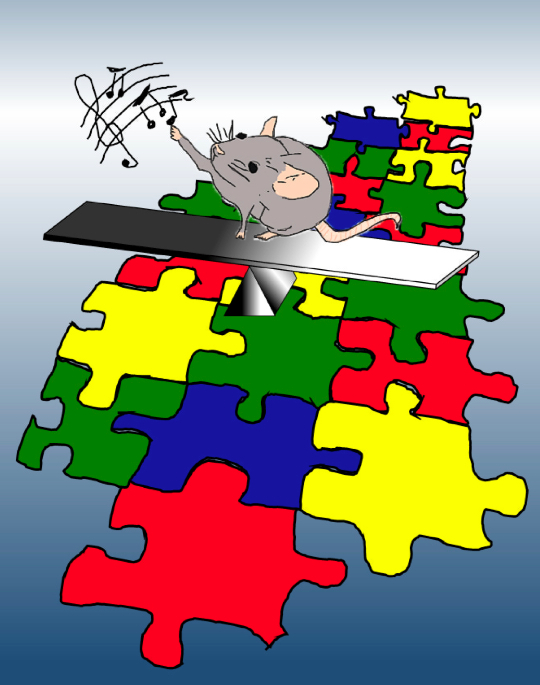
A mouse study explores how sound and touch information come together in the autistic brain (Image courtesy Nadine Gogolla)
“A high proportion of kids with autism spectrum disorder will have difficulty tolerating certain kinds of sensory inputs,” says Carolyn Bridgemohan, MD, co-director of the Autism Spectrum Center at Boston Children’s Hospital. Others, she adds, are less sensitive to certain stimuli, showing a higher tolerance for pain or excessively hot or cold temperatures.
A study published last week in Neuron uses mouse models to shed new light on the brain mechanisms that underlie sensory processing abnormalities in autism. Led by Takao K. Hensch, PhD, of the Department of Molecular and Cellular Biology at Harvard and the F.M. Kirby Neurobiology Center at Boston Children’s, researchers examined how the brain integrates sound and touch information in a deep brain region called the insula. In several studies of people with autism, the insula has come up as an area of abnormal activity or connectivity.
In normal laboratory mice, the insula’s response to simultaneous sound and touch is often stronger than the sum of its responses to each stimulus separately. However, in four separate mouse models of autism, Hensch and colleagues found that the insula’s response to sound and touch together was actually less than the sum of its parts. This abnormality in sensory integration correlated with an imbalance in “excitatory” versus “inhibitory” signaling between neurons in the brain—and it could be prevented when the excitatory-inhibitory imbalance was corrected early with medication.
“Despite ample evidence in humans that the insula is deeply involved in hallmarks of the social brain, such as empathy, pain and urges, this is the first attempt to characterize its development in an animal model of autism,” says Hensch, also a member of the Center for Brain Science at Harvard and director of the Conte Center at Harvard, focused on developmental origins of mental illness.
Scientists often think of the insula as a “hub” in the brain that is important for the normal functioning of emotion, cognition and perception, says Lisa Feldman Barrett, PhD, a professor of psychology at Northeastern University whose research focuses on emotion. “The insula sits within many different networks and allows networks to talk to one another,” she explains.
Quantifying sensory integration
Nadine Gogolla, PhD, in Hensch’s lab, now at the Max Planck Institute of Neurobiology, designed a system for visualizing and quantifying sound-touch integration in the mouse insula, using a strain of mice called BTBR with autistic features. While presenting the mice with tones of various frequencies and air puffs aimed at their forepaws, she imaged changes in their neuron activity.
In addition to the lack of sound-touch integration, the team found that certain inhibitory circuits in the insula were weakened—ones already suspect in autism and other psychiatric disorders.
As it happens, the drug diazepam is known to strengthen the activity of inhibitory circuits. When the researchers gave it to the BTBR mice soon after birth, problems in sensory integration did not develop. But given to adults, the same drug proved ineffective. To Hensch, this suggests that the insula develops sensory integration capabilities during a biological “critical period” in brain development.
Kimberly Boullard, MS, OTR/L, an occupational therapist at Boston Children’s, says this finding resonates with her three decades of experience working with children with sensory processing difficulties. The importance of early diagnosis and intervention in neurodevelopmental disorders is something that she knows well, but lacks the neurophysiology data to explain.
Intriguing questions
The mouse studies of sensory integration could be the start of a better understanding of the core pathology in autism and could potentially lead to novel therapies or early diagnostic markers. They also raise interesting questions about a possible link between sensory processing difficulties and restricted or repetitive behaviors in autism.
Specifically, the “autistic” BTBR mice were hyper-responsive to sound, but their insula response was weaker when sound was paired with touch. So Hensch wonders if the excessive grooming behavior of these mice—long viewed as pathologic—is actually an adaptive response. Could the tactile stimulation of self-grooming be relieving distress in these animals by dampening the insula overreaction to sound or other challenging stimuli? If so, one could speculate that abnormal or self-injurious behaviors in people with autism are their way of trying to deal with their brains’ sensory integration challenges.
This line of thought also piques the curiosity of clinicians such as Bridgemohan and Boullard, who often face practical questions on what to do when a child with autism seems over-stimulated. “Does persisting and providing children with multiple stimuli help eventually, or is it better not to do that?” Bridgemohan asks.
Boullard notes that many occupational therapists already operate under the theory that input through one sensory system can be used to override discomfort in another sensory system. For instance, sound or deep pressure touch is employed to try to interfere with chronic pain signals in the nervous system. And autism advocate Temple Grandin has long written about the potentially calming effects of deep pressure touch.
But there is still much to understand about the biological basis of sensory issues in autism or how effective sensory-based therapies are long-term.
“There is no evidence currently of long-term changes in kids’ neurology or long-term improvements from [sensory-based] treatment,” Bridgemohan stresses.
Along with new findings come many new questions. Just as the insula is a node through which countless brain networks pass, the present study brings together many big themes in autism research—sensory issues, socialization, repetitive behaviors, timing of interventions and the excitatory-inhibitory balance in the brain, just to name a few. While some threads in this tangle are starting to come free, they cannot yet be tied up in a neat bow.







